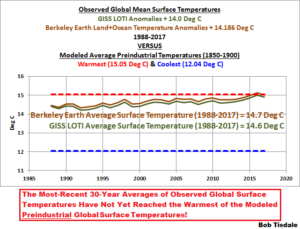by Judith Curry, November 27, 2018 in ClimateEtc.
I have now completed my assessment of sea level rise and climate change.
The complete report can be downloaded here [Special Report- Sea Level Rise ].
My preliminary compilation of information was provided in the 7 part Climate Etc. series Sea level rise acceleration (or not).
This report reflects 18 months of work on this topic. Why have I devoted so much time to the sea level rise issue? First, I regard sea level rise to be the most consequential potential impact of predicted global warming. Second, there is a great deal of public confusion about the issue, including decision makers. Third, a number of CFAN’s clients have queried me about a range of specific concerns that they have regarding sea level rise (and I have been doing consulting on this topic).
Why do I think an independent assessment of the sea level rise issue by yours truly is needed, given the plethora of international and national assessment reports? My clients are concerned about the alarmist predictions they have encountered. I have seen various ‘experts’ make public statements projecting 21stcentury sea level to be as high as 9 m [30 feet]. My clients are looking for someone that they trust to provide an objective assessment that focuses on their issues of concern.
…
by Imperial College, November 27, 2018 in ScienceDaily
…
The levels of oxygen dramatically rose in the atmosphere around 2.4 billion years ago, but why it happened then has been debated. Some scientists think that 2.4 billion years ago is when organisms called cyanobacteria first evolved, which could perform oxygen-producing (oxygenic) photosynthesis.
Other scientist think that cyanobacteria evolved long before 2.4 billion years ago but something prevented oxygen from accumulating in the air.
Cyanobacteria perform a relatively sophisticated form of oxygenic photosynthesis — the same type of photosynthesis that all plants do today. It has therefore been suggested that simpler forms of oxygenic photosynthesis could have existed earlier, before cyanobacteria, leading to low levels of oxygen being available to life.
Now, a research team led by Imperial College London have found that oxygenic photosynthesis arose at least one billion years before cyanobacteria evolved. Their results, published in the journal Geobiology, show that oxygenic photosynthesis could have evolved very early in Earth’s 4.5-billion-year history.
…
See also here
by Bob Tisdale, November 20, 2018 in WUWT
And What Have the Average Temperatures of Earth’s Surfaces Been Recently in Absolute Terms, Not Anomalies?
The answers may surprise you.
THIS POST HAS BEEN UPDATED. The update is near the end of the post.
…
So, for the purpose of this very simple illustration and comparison, and for the discussions it will generate, I’ve added 14 deg C to the annual GISS LOTI data available here, and added 14.186 deg C to the annual Berkeley Earth data. I also compared them to the 12.04 deg C to 15.05 deg C range of hindcast preindustrial global mean surface temperatures from the climate model ensemble members discussed earlier. See Figure 3. Not too surprisingly, the Berkeley Earth and GISS global mean surface temperatures, in absolute form, are very similar, with only a 0.1 deg C difference during the most recent 30-years.

…
La géologie, une science plus que passionnante … et diverse

